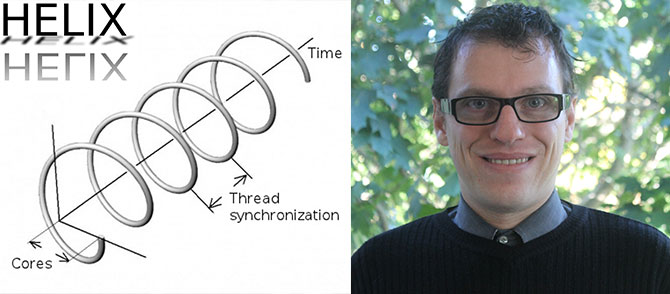Campanoni's Work on HELIX-RC is Highlighted by Communications of the ACM
His research on compiler/microprocessor co-design opens loops to parallelization by decoupling communication from thread execution in conventional multicore architecures.

Prof. Simone Campanoni has written a recent article for Communications of the ACM (CACM), titled, "Automatically Accelerating Non-Numerical Programs by Architecture-Compiler Co-Design."
In the December 2017 issue of the publication, his article presents HELIX-RC as a compiler/microprocessor co-design that opens loops to parallelization by decoupling communication from thread execution in conventional multicore architecures. Because of the dilemma of high cost of communication between processors, compilers that parallelize loops automatically have been forced to skip a large class of loops that are both critical to performance and rich in latent parallelism. Simulations of HELIX-RC, applied to a processor with 16 Intel Atom-like cores, show an average of 6.85× performance speedup for six SPEC CINT2000 benchmarks.
Supporting authors include Team HELIX members from Harvard: Kevin Brownell, Svilen Kanev, Dr. Timothy M. Jones, Prof. Gu-Yeon Wei, and Prof. David Brooks.
"This is a great deal; the Comm. of the ACM is perhaps the oldest and one of our best known publications in CS, regularly read by the community", stated Prof. Fabian Bustamante.
Prof. Campanoni's main research areas are compilers and virtual machines, with special interest in computer architecture, runtime systems, operating systems, and programming languages. Simone started the HELIX research project at Harvard University in 2010 as a post-doc working with Profs. David Brooks and Gu-Yeon Wei. HELIX uses static and dynamic compilation, run-time optimization, and architecture specialization to extract coarse-grained parallelism for many-core architectures from complex "sequential" code.
Communications of the ACM is the leading print and online publication for the computing and information technology fields. Read by computing's leading professionals worldwide, Communications is recognized as the most trusted and knowledgeable source of industry information for today’s computing professional. The prestige and unmatched reputation of Communications of the ACM is built upon a 50-year commitment to high quality editorial content and a steadfast dedication to advancing the arts, sciences, and applications of information technology.
